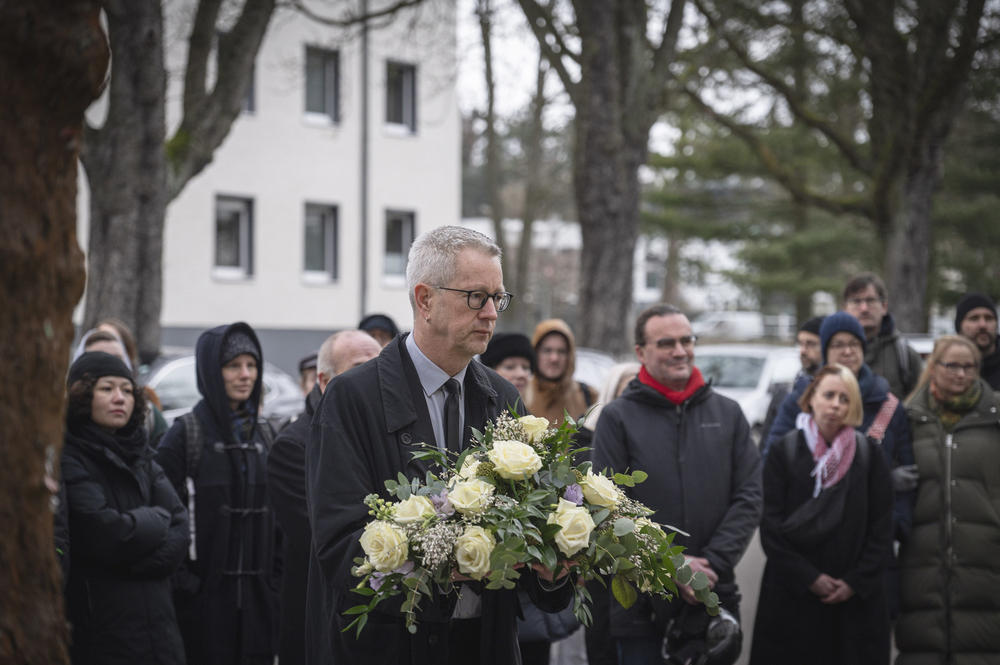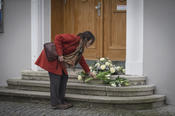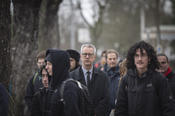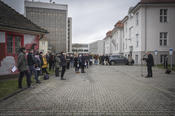“A Warning for All of Us, Showing Where Hatred Can Lead”
#WeRemember – Members of Freie Universität Berlin paid their respects to the victims of Nazi tyranny in a vigil on the campus in Dahlem.
Feb 16, 2024
University president Günter M. Ziegler and numerous others placed wreaths and flowers in front of the entrance to the building on Ihnestrasse 22 in Dahlem.
Image Credit: Bernd Wannenmacher
“We must remember and remind others,” said Günter M. Ziegler, the president of Freie Universität Berlin, at a vigil on January 26 in front of the building on Ihnestrasse 22 in Berlin-Dahlem. Numerous members of the university had gathered there to commemorate the victims of National Socialism and the liberation of the concentration camp in Auschwitz-Birkenau.
The building that now houses parts of the Otto Suhr Institute of Political Science at Freie Universität was home to the Kaiser Wilhelm Institute of Anthropology, Human Heredity, and Eugenics from 1927 to 1945. Through their research on issues related to heredity, the scientists working there were involved in the National Socialist crimes. The anthropologist and racial hygienist Eugen Fischer worked in the building on Ihnestrasse 22 from 1927 onward. Otmar von Verschuer, who succeeded Eugen Fischer as institute director in 1942, also conducted research in this building. One of his main research interests was twins. He wanted to prove that diseases and mental illnesses, as well as tendencies toward certain character traits, are hereditary. His doctoral student was Josef Mengele, who later worked as a medical doctor in the concentration camp in Auschwitz, where he conducted inhumane medical experiments on inmates. Mengele sent the organs and other body parts of individuals murdered in the concentration camp to the Kaiser Wilhelm Institute of Anthropology, Human Heredity, and Eugenics for research purposes.“A Challenge Not to Look Away, But to Act” – speech by Günter M. Ziegler
In his speech the university president explained what remembering the crimes of the National Socialist period means for the present:
“Outrage remains. The absurdity and senselessness of the murder of millions of Jews, Sinti and Sintizze, Roma and Romnja, homosexuals, people with disabilities, and many more remains. It is difficult to express the extent of this horror in words. Indeed, it is simply not possible. With the International Holocaust Remembrance Day and Germany’s Day of Remembrance for the Victims of National Socialism, both of which are observed every year on January 27, we think of the almost endless number of fates, of victims of a cruel state policy of racism and antisemitism. We try to remember specific individuals. All of these victims are a reminder to us of where hatred can lead. They are a challenge not to look away, but to act – even today.
This horror was not just the result of actions taken by a small group of people whose names will forever be linked with this barbaric part of German history. This horror was made possible by a large majority of people who remained silent and, in doing so, facilitated this suffering. This horror occurred at universities and research institutions across Germany. And it also occurred here. Here, in this building that formerly housed the Kaiser Wilhelm Institute of Anthropology, Human Heredity, and Eugenics. Here, in this building, inhumane experiments were conducted on Jews, Sinti and Sintizze, Roma and Romnja, people of color, and people with disabilities. Today we can hardly express this horror with words. However, for the sake of those who suffered, we must try.
I would expressly like to thank Professor Bernbeck and Professor Pollock for their support, organization, and hard work as well as the members of the research project ‘History of Ihnestrasse 22’ under the directorship of Dr. Bauche, who are doing important work for coming to terms with the crimes committed in the name of science and research under National Socialism. Later this year the ‘Ihnestrasse Memorial’ exhibition, which has been in preparation for a long time, will be officially opened. We are all looking forward to the exhibit because we know how important it is.
Especially now, when we are once again seeing a significant increase in antisemitic and anti-Muslim acts in Berlin and around the world, we are all called upon to act and not to look away. By ‘we,’ I mean all of us – as scholars and scientists, as a research institution, and as individuals. Let us remember the several million individual people who became victims of a horrific system of racism, antisemitism, and discrimination. Let us work together to ensure that such a crime can never be repeated.”
Making the Victims of National Socialist Tyranny Heard
During the memorial event, members of Freie Universität read aloud from texts about some of the victims of National Socialism, including the Italian writer Primo Levi.
As part of the project “History of Ihnestrasse 22,” research was conducted on the lives of three people whose fates are related to the crimes that occurred at the Kaiser Wilhelm Institute of Anthropology, Human Heredity, and Eugenics: Agnes W., Otto Rosenberg, and Ilse Weber. Students and members of the university read excerpts from the letters and memories of these three individuals during the memorial event.
Agnes W. grew up in a poor family in Berlin and was only able to attend school for a few years. In 1935 a physician determined that she suffered from “congenital imbecility.” This diagnosis served as a means to declare people whose behavior and education did not meet the standards of the time as sick and handicapped. With this diagnosis, Agnes W. was supposed to be sterilized. She successfully resisted this decision several times. Her appeals were dismissed by, among others, Eugen Fischer, the director of the Kaiser Wilhelm Institute of Anthropology, Human Heredity, and Eugenics. In November 1936 the 42-year-old single mother of three children was sterilized against her will.
Otto Rosenberg, a Sinto in Berlin, was examined by Eva Justin, a “race researcher” at the Kaiser Wilhelm Institute of Anthropology, Human Heredity, and Eugenics, where she conducted “race research.” With her work she contributed to the mass deportation of Sinti and Sintizze as well as Roma and Romnja. In April 1943 Otto Rosenberg and his family were deported to the Auschwitz-Birkenau concentration camp. He was one of the few members of his family to survive the genocide. He later became active in the Berlin-Brandenburg State Association of German Sinti and Roma and campaigned for the recognition of these murders as genocide.
In 1942 Ilse Weber was deported to the Theresienstadt concentration camp, where she took care of the children in the pediatric infirmary. In October 1944 all of the children in the camp were deported to Auschwitz, and Ilse Weber accompanied them voluntarily. An acquaintance of hers who was already in Auschwitz reported that all of them were gassed upon arrival. Ilse Weber went to her death, singing with the children.
This summer a new permanent exhibit “Ihnestrasse Memorial. Science and Injustice” will open in the building and outdoor area of the former premises of the Kaiser Wilhelm Institute of Anthropology, Human Heredity, and Eugenics at Ihnestrasse 22. It will provide background information and make the history of this location visible.The original German version of this article appeared in campus.leben, the online magazine published by Freie Universität Berlin.




